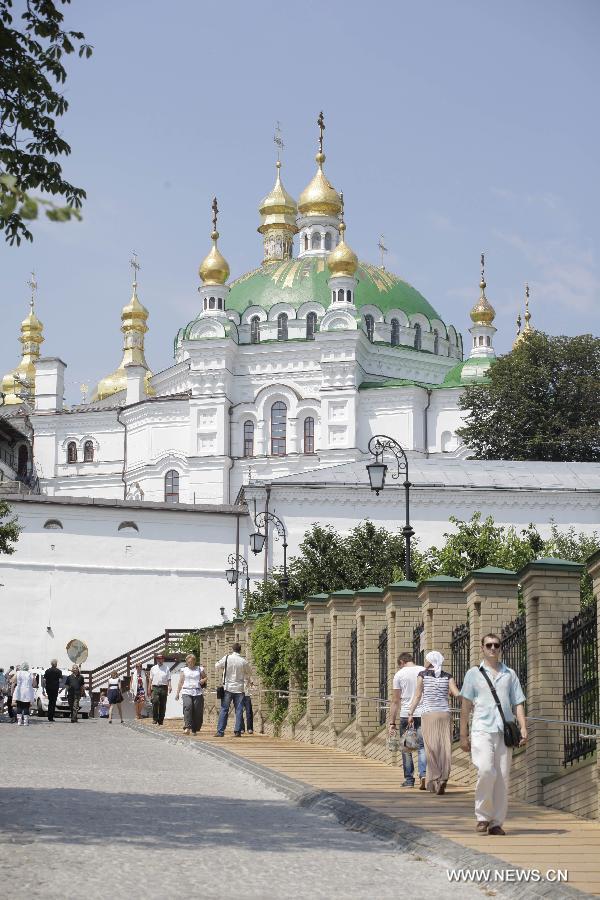
Photo taken on July 2, 2013 shows the Kiev-Pechersk Lavra in Kiev, Ukraine. Kiev-Pechersk Lavra is nominally divided into two parts: the Upper Lavra, where the museums, shops and churches are situated and the Lower Lavra, underground area, where mummified bodies of Orthodox Saints are conserved. The spiritual and intellectual influence of Kiev-Pechersk Lavra contributed to the spread of Orthodox thought and the Orthodox faith in the Russian world from the 17th to the 19th century. Together with Saint-Sophia Cathedral and Related Monastic Buildings, Kiev-Pechersk Lavra was included in UNESCO's World Heritage List in 1990.(Xinhua/Alexandr Shilov) 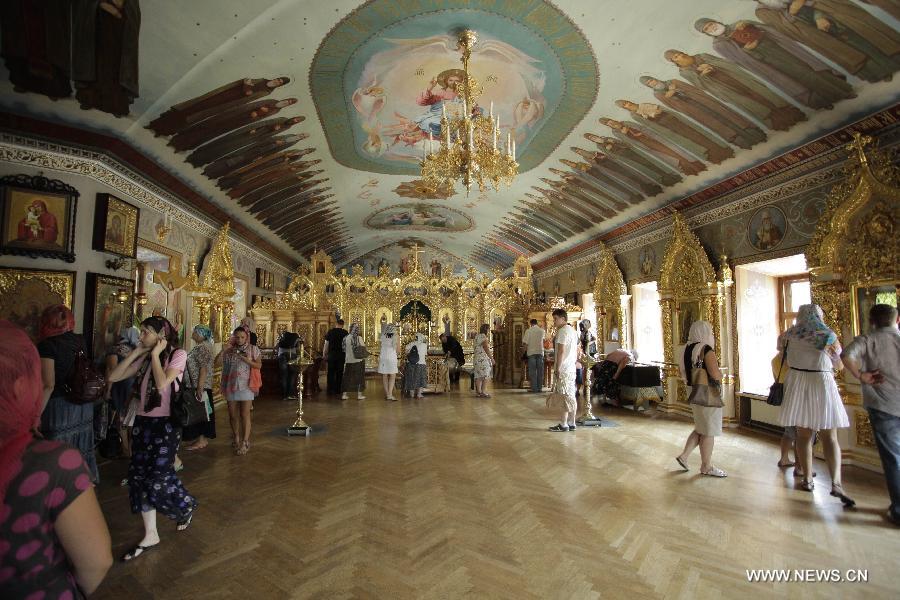
Tourists visit the Kiev-Pechersk Lavra in Kiev, Ukraine, July 2, 2013. Kiev-Pechersk Lavra is nominally divided into two parts: the Upper Lavra, where the museums, shops and churches are situated and the Lower Lavra, underground area, where mummified bodies of Orthodox Saints are conserved. The spiritual and intellectual influence of Kiev-Pechersk Lavra contributed to the spread of Orthodox thought and the Orthodox faith in the Russian world from the 17th to the 19th century. Together with Saint-Sophia Cathedral and Related Monastic Buildings, Kiev-Pechersk Lavra was included in UNESCO's World Heritage List in 1990.(Xinhua/Alexandr Shilov) |

Photo taken on July 2, 2013 shows the Kiev-Pechersk Lavra in Kiev, Ukraine. Kiev-Pechersk Lavra is nominally divided into two parts: the Upper Lavra, where the museums, shops and churches are situated and the Lower Lavra, underground area, where mummified bodies of Orthodox Saints are conserved. The spiritual and intellectual influence of Kiev-Pechersk Lavra contributed to the spread of Orthodox thought and the Orthodox faith in the Russian world from the 17th to the 19th century. Together with Saint-Sophia Cathedral and Related Monastic Buildings, Kiev-Pechersk Lavra was included in UNESCO's World Heritage List in 1990.(Xinhua/Alexandr Shilov) 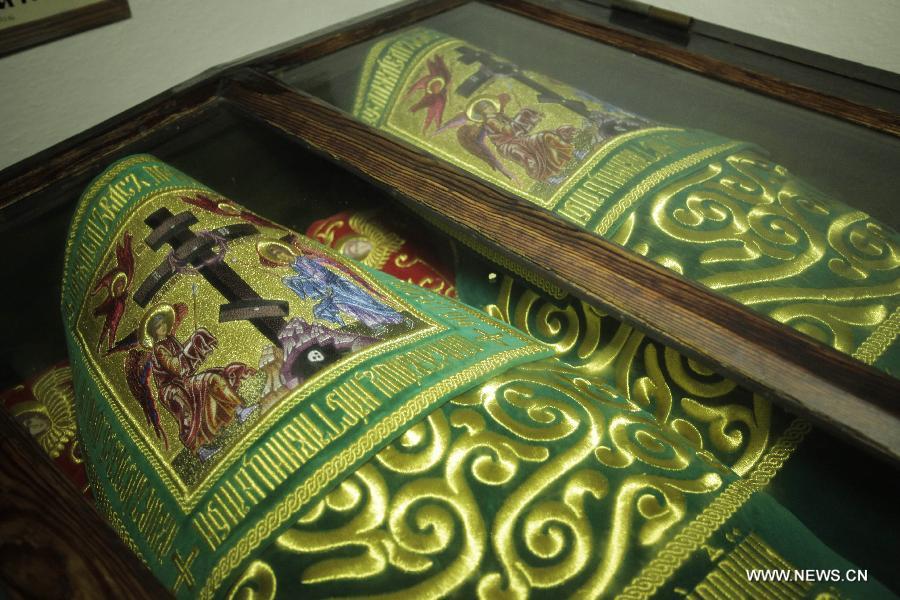
Photo taken on July 2, 2013 shows the mummified bodies of Orthodox Saints at the Kiev-Pechersk Lavra in Kiev, Ukraine. Kiev-Pechersk Lavra is nominally divided into two parts: the Upper Lavra, where the museums, shops and churches are situated and the Lower Lavra, underground area, where mummified bodies of Orthodox Saints are conserved. The spiritual and intellectual influence of Kiev-Pechersk Lavra contributed to the spread of Orthodox thought and the Orthodox faith in the Russian world from the 17th to the 19th century. Together with Saint-Sophia Cathedral and Related Monastic Buildings, Kiev-Pechersk Lavra was included in UNESCO's World Heritage List in 1990. (Xinhua/Alexandr Shilov) |
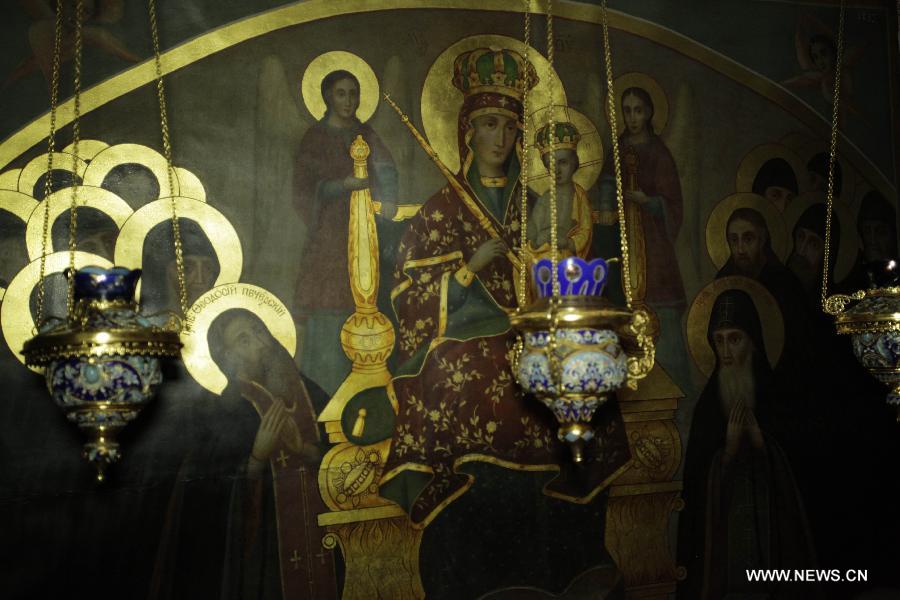
Photo taken on July 2, 2013 shows the mural at the Kiev-Pechersk Lavra in Kiev, Ukraine. Kiev-Pechersk Lavra is nominally divided into two parts: the Upper Lavra, where the museums, shops and churches are situated and the Lower Lavra, underground area, where mummified bodies of Orthodox Saints are conserved. The spiritual and intellectual influence of Kiev-Pechersk Lavra contributed to the spread of Orthodox thought and the Orthodox faith in the Russian world from the 17th to the 19th century. Together with Saint-Sophia Cathedral and Related Monastic Buildings, Kiev-Pechersk Lavra was included in UNESCO's World Heritage List in 1990. (Xinhua/Alexandr Shilov) |

Photo taken on July 2, 2013 shows a mummified body of a Orthodox Saint at the Kiev-Pechersk Lavra in Kiev, Ukraine. Kiev-Pechersk Lavra is nominally divided into two parts: the Upper Lavra, where the museums, shops and churches are situated and the Lower Lavra, underground area, where mummified bodies of Orthodox Saints are conserved. The spiritual and intellectual influence of Kiev-Pechersk Lavra contributed to the spread of Orthodox thought and the Orthodox faith in the Russian world from the 17th to the 19th century. Together with Saint-Sophia Cathedral and Related Monastic Buildings, Kiev-Pechersk Lavra was included in UNESCO's World Heritage List in 1990.(Xinhua/Alexandr Shilov) |
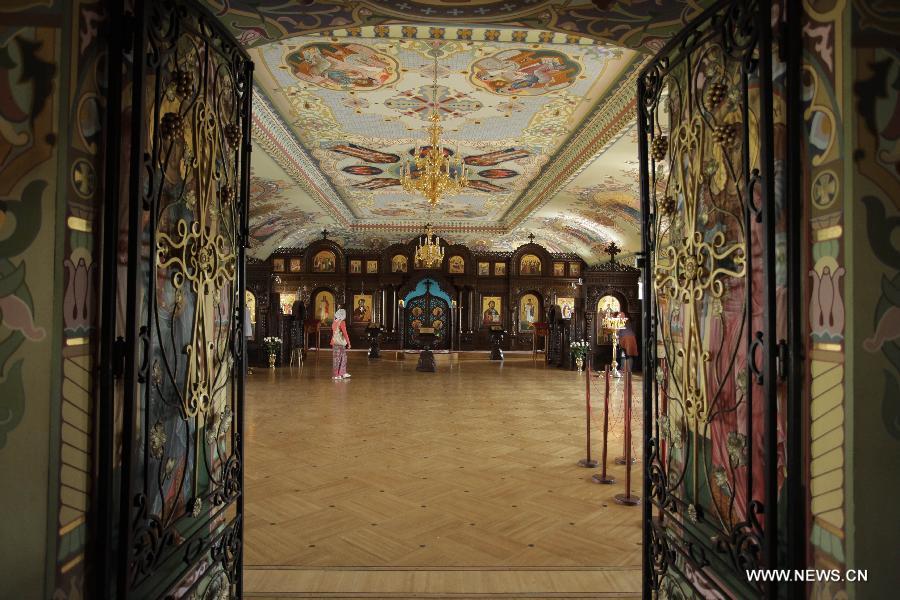
Photo taken on July 2, 2013 shows a hall at the Kiev-Pechersk Lavra in Kiev, Ukraine. Kiev-Pechersk Lavra is nominally divided into two parts: the Upper Lavra, where the museums, shops and churches are situated and the Lower Lavra, underground area, where mummified bodies of Orthodox Saints are conserved. The spiritual and intellectual influence of Kiev-Pechersk Lavra contributed to the spread of Orthodox thought and the Orthodox faith in the Russian world from the 17th to the 19th century. Together with Saint-Sophia Cathedral and Related Monastic Buildings, Kiev-Pechersk Lavra was included in UNESCO's World Heritage List in 1990.(Xinhua/Alexandr Shilov) |

Photo taken on July 2, 2013 shows the Kiev-Pechersk Lavra in Kiev, Ukraine. Kiev-Pechersk Lavra is nominally divided into two parts: the Upper Lavra, where the museums, shops and churches are situated and the Lower Lavra, underground area, where mummified bodies of Orthodox Saints are conserved. The spiritual and intellectual influence of Kiev-Pechersk Lavra contributed to the spread of Orthodox thought and the Orthodox faith in the Russian world from the 17th to the 19th century. Together with Saint-Sophia Cathedral and Related Monastic Buildings, Kiev-Pechersk Lavra was included in UNESCO's World Heritage List in 1990.(Xinhua/Alexandr Shilov) |
|